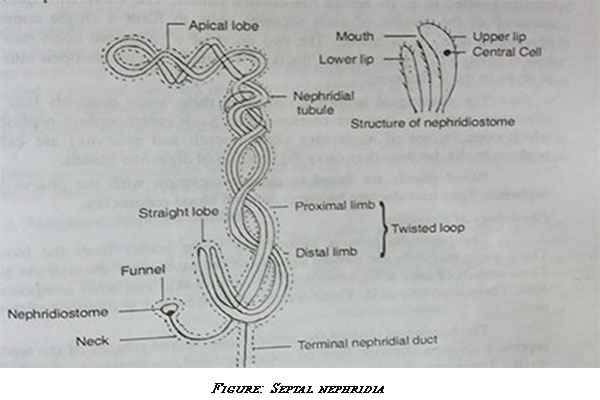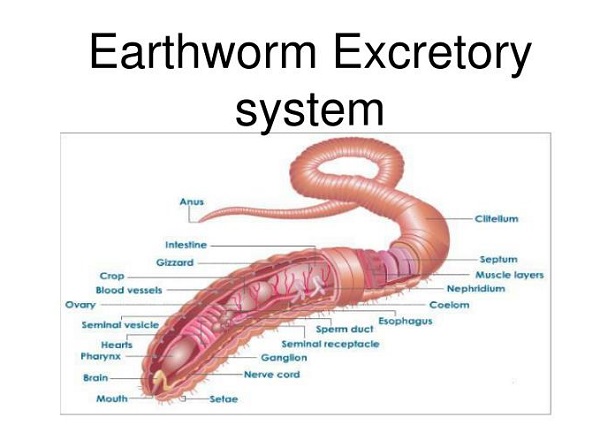Excretory system of Earthworm
Excretory system of Earthworm
The process of removal of metabolic waste products including nitrogenous material like ammonia, urea, uric acid, amino acid, etc. from the body is called excretion.
Excretory system consists of nephridia as excretory organ which is analogous to kidney of vertebrates.
Nephridia are porous, long, thin and coiled tube which are found in all segments except first three.
Types of Nephridia
According to their position in the body, they are of 3 types:
- Septal Nephridia/ Typical Nephridia
- Pharyngeal Nephridia
- Integumentary Nephridia
-
Septal Nephridia or Typical Nephridia

They are well developed and the largest nephridia, and found attached to both sides of each intersegmental septum behind the 15th segment.
Each septum has 40-50 septal nephridia and they are arranged in two rows. So each septum has 80-100 septal nephridia.
It consists of 3 main parts:
a. Nephridiostome: also called Nephrostome.
It is funnel shaped and externally ciliated, opening into the coelomic cavity.
It consists of mouth like opening, which is surrounded by larger upper lip and smaller lower lip.
Upper lip is formed by a large central cell and eight or nine marginal cell, whereas the lower lip is formed of four or five compact cells. The lips have several rows of cilia.
Funnel leads into a short and narrow-ciliated neck, which is continued into the body of the nephridium.
Due to continuous movement of cilia all the nitrogenous substances of the coelomic fluid are absorbed in the nephridium.
b. Body
It is the main tubular part of the nephridia which is coiled around at its axis.
It consists of two parts:
1. Short straight lobe- is one half of the twisted loop.
It is short, straight tube which remains attached to the twisted loop.
2. Long twisted loop with narrow apical lobe.-
The twisted loop consists of proximal and distal limb, which are spirally twisted upon each other.
Proximal limb is attached to neck and terminal duct of the twisted loop, while the distal limb to the straight lobe.
The number of twist varies from 9-13.
c. Terminal duct
It is the end part of the main body.
Only one intracellular canal.
Proximal limb of the body of nephridium ends in a short and narrow duct called terminal duct.
All the terminal ducts of a segment open into septal excretory duct of their side. Septal excretory duct collect the excretory products and transfer them to a pair of supra-intestinal excretory duct.
Nephridial tube
Nephridium consists of a syncytial glandular mass, inside which coiled tubules run that end up in a narrow terminal duct that opens into excretory duct and eventually lead into the intestine through supra intestinal excretory duct. Coiled tubules have four ciliated tract, one in neck, two in body and one in terminal duct. There are four parallel tubules in the straight lobe, 3 in the basal part and two in the apical part of each limb of the twisted loop and a single tubule in each of the neck and terminal duct.
Function of septal nephridia
Septal nephridia discharge the waste products through canal and ducts into the lumen of the intestine. So they are enteronephric.
2. Pharyngeal nephridia
They are found as paired and lie one pair in each of the 4th, 5th and 6th segment.
They are similar to septal nehridia in structure but they lack nephrostome (contain short straight lobe and spirally twisted loop).
Lumen has ciliated canal.
NOTE: The terminal nephridal ducts of all the tubules of each segment unite to form a single common pharyngeal ducts in each side.
They have 3 pair of nephridial canal/duct.
The duct arise from 6th segment which opens into buccal cavity in 2nd segment, the ducts of 4th and 5th segment opens into the pharynx in 4th segment.
Function:
They discharge the waste products directly into the buccal cavity and pharynx from where these are passed outside with undigested food through the anus. So they are called enteronephric nephridia.
3. Integumentary Nephridia
They are attached to the inner side of the body wall from 7th to last segment.
They are smaller than septal nephridia.
Each nephridium is V-shaped with short straight lobe and twisted loop without nephridiostome or funnel.
Their lumen has two ciliated canals.
Their terminal nephridial ducts are also very short which open on the outer surface of the body wall by nephridiopores.
The number of integumentary nephridia ranges from 200-250 in each segment but in clitellar region, their number is about 2000-2500. So clitellum is called forest of nephridia.
Function:
They discharge nitrogenous metabolic waste products directly outside from the body through nephridiopores. So they are called exonephric nephridia.
Physiology of Excretion
Since the nephridia are richly supplied with capillaries, they collect the nitrogenous waste matter and remove from the body.
NOTE: The nitrogenous wastes are thrown out at the intervals of three days.
The beating of cilia of the nephridiostome drives a constant flow of coelomic fluid containing metabolic waste along with some other useful substances. The useful substances are absorbed by the body and the metabolic wastes reach the proximal limb of the twisted loop from the nephridiostome. Then they are transferred to the distal limb from where it reaches the straight lobe. When the excretory matters move in the nephridia they are converted into urea and ammonia. These are then passed into the gut through supra-intestinal excretory duct by enteronephric nephridia or outside by the nephridiopores by exonephric nephridia.
NOTE: Earthworm is ureotelic because its nitrogenous waste matter consist of 40% urea, 20% ammonia, 40% amino acid and other nitrogenous compound.
Excretory system of Earthworm


thanks a lot….I am a class 11 student and it was a great help making note
This information is enough to understand this topic
Good job this is help full to understand the topic
Best study material .I like it.
I like it ….notes …..
I am a student of BS zoology…
it is helpful to me for my assignment…
Your notes includes all information tq mam😍😍
That is very better because its helpful to my study
tks .it’s really helpful.
Thanks for the notes……it’s help me so much…
This really help me out …… thanks!!!
Great notes
Great help for me thankyou
Thank u mam
Helpful..note
It very helpful in understanding
Thank you
It was nice to score more in exam thank you so much
Thanks
Thanks so much for more knowledge
this information is enough to explain this topic
Awsom super fabuluous informtion given .
Since i am studying in 1st bsc (CZMB)
THIS is really an extraordinary information thank u soo much.
Not only for zoology part i need the same quality of information in chemistry and microbiology toooo
Thank u sooo much